Text
Ultimate Beginner Guide for Guitar Lovers (Basic Tips)
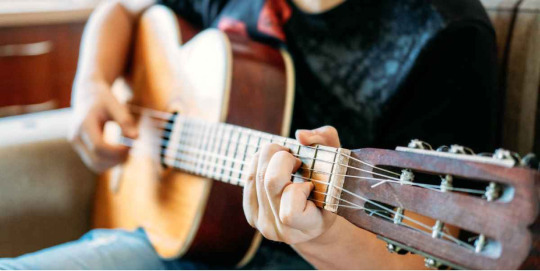
1)Acoustic guitars: Acoustic guitar generates sound without an exterternal power supply- specially known for its organic and warm tones. The tones generally vary based on the body size, wood type, and craftsmanship.
2)Electric guitars: Electric Guitars are heavy in general and are well-known for their versatility in pop, jazz, blues, and rock. It requires amplifiers and pedals to produce sound like distortion, reverb, delay, and more.
Now, go grab your fit. You must also know about the guitar parts as well.
Tuning and Care:
It’s important to know how to tune your guitar before you start performing. You can use a tuner or tuning app. Also, cleaning and string changes are critical for better sound and the health of your instrument.
Practice is the key:
It takes time, patience, and constant practice to learn to deal with finger pain and chord transition. You have to be very consistent and add it to your daily routine. Explore learning resources—recommended apps, guitar classes, websites, and YouTube tutorials for a better and quicker guide. You might find it difficult to understand scales, read tabs, and learn chord charts but with time, you can master it.
Read More: Ultimate Beginner Guide for Guitar Lovers
0 notes
Text
4 EXPERT TIPS TO PROTECT YOUR GUITAR WHILE TRAVELING

We know your guitar is your baby. So, any travel plans that include carrying your instrument can be stressful. Whether carrying your guitar for a performance or on a solo vacation, you can’t be too careful. Here are 4 expert tips to protect guitar parts from hits, drops, and scratches. Keep reading!
But a soft case will do just fine if you plan to carry on your guitar. It will easily fit inside the overhead compartment. Alternatively, you can also slide under the seat. If you get a seat with extra legroom, you’re sorted! You can buy a high quality guitar case from online guitar parts selling brands.
The Must-Do’s On The Day Of Your Travel
Now that you know how to prep your guitar, it’s time to be a smart traveler. Here’s what you need to do on your day of travel.
Check-in early-It will buy you more time for TSA of your instrument. For sure, guitars will be heavily inspected. So, staying ahead of the schedule makes sense. You can also board the plane earlier and easily access the overhead compartment for a carry-on.
Read More: TIPS TO PROTECT YOUR GUITAR WHILE TRAVELING
0 notes
Text
How To Clean And Maintain Your Electric Guitar Fretboard

Finished and Unfinished Fretboards
The guitar community is torn in a debate about whether the material of a fretboard makes any difference. Some believe that a rosewood fretboard is markedly different from ebony, while others say there’s hardly any difference. But when it comes to cleaning, you will need to be cautious.
Primarily, the focus is on fretboard cleaning, but other guitar parts are involved, like the neck and tuning pegs. And if your electric guitar has a fretboard that uses unfinished wood, things are tricky, demanding extreme caution. So, it’s recommended to oil unfinished fretboards for obvious reasons.
When you leave wood for a long time, it turns hard, thereby making it difficult for the truss rod-neck adjustment.
Unoiled fretboards can also crack in places that look bad and hamper your guitar play.
How To Start Cleaning Your FretBoard
For maple fretboards, you don’t have to spend time oiling. Typically, they are pre-hydrated with carnauba wax that wicks away excessive dirt. So, you can start right away by wiping at the neck and body using a slightly damp microfiber cloth.
In contrast, you must use lemon oils to hydrate rosewood and ebony fretboards. Take a small cotton bulb, lightly moisten it in lemon oil, and rub it along the fretboard and neck. Make sure you dust out any excessive dirt before.
Expert Tips :
Before you start cleaning the fretboard, always loosen the guitar strings. If you’re a beginner, use a special string cleaning tool to push the grime under the strings.
You can buy one from e-commerce stores selling online guitar parts and accessories.
Always tape the pickup before starting to clean a fretboard.
Lie down your guitar on a sturdy surface. Ensure the neck is well supported and the fingerboard is kept horizontal.
Read More: How To Clean And Maintain Your Electric Guitar Fretboard
0 notes
Text
7 BEST ELECTRIC GUITARS 2023

3) Squire Classic Vibe Telecaster
The Squier Classic Vibe Telecaster Thinline ’60s is a guitar that combines the timeless aesthetics of the pat with playability. It has left an incredible mark on the world of music. The guitar parts are beautifully built and it pays homage to the iconic ’60s Telecaster while offering affordability and contemporary performance. Whether you’re a musician, in search of that Telecaster sound or a beginner looking for a great starting point in the world of electric guitars this Telecaster is an excellent choice. It captures the essence of an era while providing all the conveniences of today.
4) Epiphone Les Paul Classic
A timeless icon with modern versatility is Epiphone Les Paul Classic. Whether it is the guitar bridge, the tailpiece, or the strings, the beautiful design has captivated the musicians for decades. The Epiphone Les Paul Classic strikes the balance between timeless aesthetics and modern features offering guitar enthusiasts a combination of style and playability at an affordable price. Here’s why this guitar has gained such a reputation;
D. Weight relief System
To ensure comfort during those playing sessions Gibson has incorporated a weight relief system into the Les Paul Tribute. This system selectively removes sections of the body to reduce weight without sacrificing any of the guitar’s tone or resonance. As a result you can play for hours without straining your back or getting fatigued.
In terms of sustain the Nashville Tune o matic bridge paired with a stopbar guitar tailpiece not ensures rock tuning stability but also delivers that vintage Les Paul sustain that has made this guitar an enduring favorite among musicians.
7) Gretsch Centerblock Jr
bbThe Gretsch Electromatic G5655TG Center Block Jr. Is more than a guitar; it’s a piece that combines captivating aesthetics with an impressive tonal range that will surely captivate any musician. Whether you’re a player or a budding guitarist this Gretsch model offers a blend of vintage elegance and modern performance making it an exceptional addition to any collection.
Read More: 7 BEST ELECTRIC GUITARS 2023
0 notes
Text

Find the Right Guitar for You
The first and most important step is finding a guitar. Not just any guitar, the guitar that is the right one for you. Yes, the options are endless, and narrowing down your choice to just one is a tough one. Luckily you can change your mind and guitar whenever you see fit.
As the saying goes, it is better to have a guitar that is hard to play than no guitar at all … but if you have a choice, choosing one that fits your hand and body size quite comfortably is going to be a great help to your learning process.
If you’re looking for the ideal guitar, you might want to explore online guitar parts to help you customize and fine-tune your instrument to perfection.
Learn How to Tune Your Guitar
As time passes and you become a master of your chosen craft, you will eventually be able to tune your new best friend by ear. But until such time, using a tuner is the best way to get your guitar to play the right notes.
There are 4 main types of tuners that players use nowadays, and they include vibration-based tuners, pedal tuners, microphone-based tuners, and Smartphone apps.
Identifying the Strings
Learning the parts and pieces of your guitar is paramount to you learning and really enjoying your instrument. Learning which strings are which is really going to make the learning experience that much more enjoyable and a whole lot less frustrating.
Starting with the thickest string on top and the thinnest at the bottom, their names are; E, A, D, G, B, and E, respectively. That being said, your thickest string is E, or the 6th string, and the thinnest string is your E, or 1st string.
Read More: Learn to play the guitar from the comfort of your couch
0 notes
Text
Guitar Bridge 101: Types of Guitar Bridge Parts & Their Use

The first step is to figure out which bridge you already have on your guitar and what you want to accomplish with the upgrade. The first step in figuring out what you have is to consider which brand you want to replace it with. Gibson, Epiphone, and other imported guitars (Tokai, Ibanez, Burny, and so on) have somewhat different bridge measurements, requiring slightly different parts. All of these can be found at Guitar Parts as suitable replacements. Read the following guide to each component and discover what matches your instrument before settling on a bridge.

You can use one of our conversion bridge studs to convert your import model to match a USA-style bridge (such as our ABRM or Tone-Lock bridge). These studs are simple to install and, in the case of the ESWKIT, require no changes to your current setup. The E-Sert installation instructions are in video format on the FaberUSA.com website’s “Help” section.
• Faber ESWKIT – This guitar bridge stud set will fit into your existing import guitar bushings, allowing you to utilise one of our USA-style bridges without having to modify your body. It’s a straightforward “remove and replace” solution.”
• Faber E-Sert – The E-Sert range removes the tone-robbing non-steel bushings that come standard on most import guitars. You can also use our ABR and Tone-Lock model bridges with these bridge mounting posts. One pair of steel studs and a thumbwheel for action adjustment are included with the E-Sert studs. The posts that are attached to the bushings will transfer the most vibrations into the instrument and boost the guitar’s sustain.
Suppose your guitar has a one-piece wraparound bridge. In that case, Faber guitar parts also provide a tailpiece with compensated edges to aid with intonation, as well as our Wraptonate tailpiece, which is a fully inntonatable wraparound bridge.
Read More: Guitar Bridge 101: Types of Guitar Bridge Parts & Their Use
0 notes
Text
How To Setup Tune-O-Matic Bridge With Gibson Guitar


The Tune-O-Matic bridge is an indispensable component of any Gibson guitar, serving as the linchpin for achieving impeccable intonation and action. This article will walk you through the steps of installing a Tune-O-Matic bridge on your prized Gibson instrument. You’ll unlock the full potential of your guitar’s sound capabilities by meticulously addressing each aspect of this process.
Understanding the nuances of guitar parts, particularly the guitar bridge, is pivotal for any dedicated guitarist. The Tune-O-Matic bridge parts are engineered with precision, ensuring that they harmonize seamlessly with the Gibson legacy. We’ll take the time to modify everything from bridge height to tailpiece alignment.
Tools and Materials Needed
Before embarking on this musical journey, you must gather the following tools and supplies, as this is the canvas on which you’ll paint your aural masterpiece – “A Gibson guitar with a Tune-O-Matic bridge”. The following items will be essential for the task.
Guitar tuner: This tool is the cornerstone of achieving perfect tuning for your guitar. It makes sure that the strings are at the correct pitch and that harmonious music is produced when you play the guitar.
Screwdrivers and Allen Wrenches: These are required for altering the bridge height. When you fine-tune the bridge height, you can tailor the action of the strings, which means it will affect how easy or hard it is to play the strings. Hence, you can achieve a comfortable playability.
String Winder: An invaluable tool for detuning and restringing your guitar, so when you change the strings for maintenance or explore various string gauges, the task is simplified. You save time and effort in this process.
New String Set (Optional): Strings wear out after some time and need to be changed. Fresh strings can give your instrument a crisp and vibrant tone. It will breathe new life into the guitar sound.
Read More: How To Setup Tune-O-Matic Bridge With Gibson Guitar
1 note
·
View note
Text
Setup Gibson Les Paul Bridge – Installation Guide
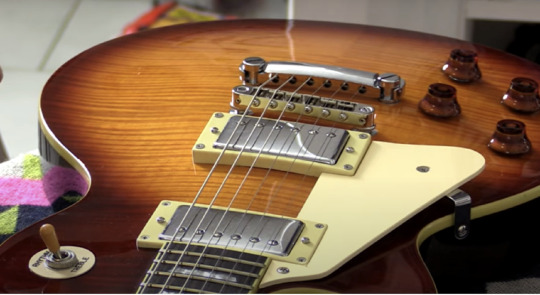
The Gibson Les Paul is a classic electric guitar that has been a favorite of guitarists for generations. One of the most important components of the Les Paul is the bridge, which plays a crucial role in determining the guitar’s sound and playability. Here, we’ll be discussing a step-by-step guide on how to set up a Gibson Les Paul bridge, with a focus on the Tune-O-Matic bridge and its components, such as the guitar bridge saddles and guitar tailpiece.
Before we get started, it’s important to have a basic understanding of the parts of a guitar bridge. The bridge is part of the guitar that holds the strings in place and allows for adjustments in string height and intonation. The Les Paul bridge, also known as the Tune-O-Matic bridge, is a popular choice for many guitarists due to its high level of adjustability and ability to improve the guitar’s intonation.
The Les Paul bridge consists of several components, including the bridge itself, bridge posts, bridge studs, bridge saddles, and the guitar tailpiece. The bridge posts and studs are responsible for holding the bridge in place and allowing for height adjustments. The bridge saddles, located on top of the bridge, are the parts that the strings sit on and are responsible for intonation adjustments. The tailpiece is located behind the bridge and anchors the strings to the guitar body.
Step 1: Remove the old strings.
Before installing the new bridge, you’ll need to remove the old strings. Loosen the tuning pegs and unwind the strings from the bridge. Once all strings are removed, remove the old bridge from the guitar.
Step 2: Install the new bridge
Insert the bridge posts into the corresponding holes in the guitar body. Next, place the bridge on top of the posts and tighten the screws that hold the bridge in place. Make sure the bridge is centered over the guitar body and that the distance between the bridge and the tailpiece is correct.
Step 3: Adjust string height
Using a ruler or calliper, measure the distance between the bottom of each string and the top of the 12th fret. Adjust the height of the bridge saddles to achieve the desired string height. Make sure to adjust each saddle individually to ensure that the string height is even across all strings.
Step 4: Adjust intonation
With the strings at the correct height, it’s time to adjust the intonation. Using a guitar tuner, play the open string, and then play the same string at the 12th fret. If the note at the 12th fret is sharp, move the saddle back, and if it’s flat, move the saddle forward. Repeat this process for each string until the intonation is correct.
Overall, the Les Paul bridge, also known as the Tune-O-Matic bridge, is a critical component of the Gibson Les Paul guitar. By understanding the different parts of a guitar bridge, such as the bridge posts, studs, saddles, and tailpiece, and following the steps outlined in this guide, you can set up your Les Paul bridge for optimal sound and playability.
Read More: How To Setup Gibson Les Paul Bridge
0 notes
Text
How To Setup Gibson Les Paul Bridge – Installation Guide
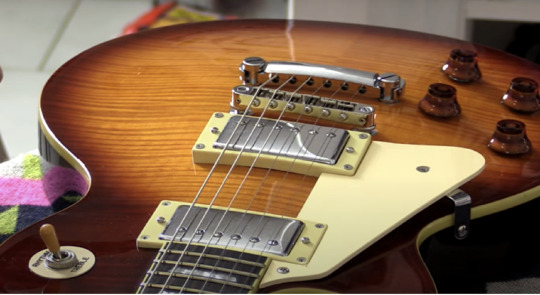
The Gibson Les Paul is a classic electric guitar that has been a favorite of guitarists for generations. One of the most important components of the Les Paul is the bridge, which plays a crucial role in determining the guitar’s sound and playability. Here, we’ll be discussing a step-by-step guide on how to set up a Gibson Les Paul bridge, with a focus on the Tune-O-Matic bridge and its components, such as the guitar bridge saddles and guitar tailpiece.
Before we get started, it’s important to have a basic understanding of the parts of a guitar bridge. The bridge is part of the guitar that holds the strings in place and allows for adjustments in string height and intonation. The Les Paul bridge, also known as the Tune-O-Matic bridge, is a popular choice for many guitarists due to its high level of adjustability and ability to improve the guitar’s intonation.
Step 1: Remove the old strings.
Before installing the new bridge, you’ll need to remove the old strings. Loosen the tuning pegs and unwind the strings from the bridge. Once all strings are removed, remove the old bridge from the guitar.
Step 2: Install the new bridge
Insert the bridge posts into the corresponding holes in the guitar body. Next, place the bridge on top of the posts and tighten the screws that hold the bridge in place. Make sure the bridge is centred over the guitar body and that the distance between the bridge and the tailpiece is correct.
Step 4: Adjust intonation
With the strings at the correct height, it’s time to adjust the intonation. Using a guitar tuner, play the open string, and then play the same string at the 12th fret. If the note at the 12th fret is sharp, move the saddle back, and if it’s flat, move the saddle forward. Repeat this process for each string until the intonation is correct.
Read More: Installation guide to setup Gibson Les Paul Bridge
1 note
·
View note
Text
Parts Of An Electric Guitar Explained
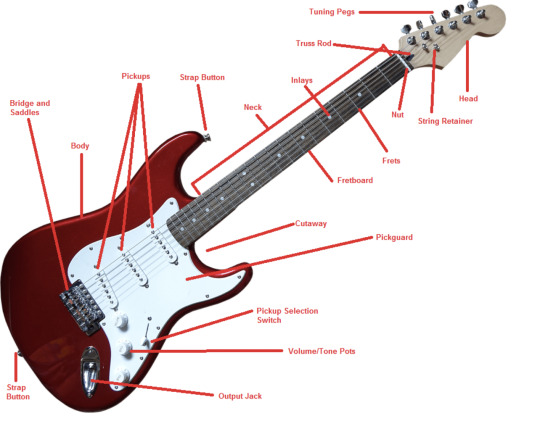
The Headstock
The tuning machines, which are located in the headstock at the top of the guitar’s neck and are used to change the tension of the strings to accomplish the desired pitch, are located here. Its shape and design can vary based on the manufacturer and guitar style, and it is typically made of wood. Additionally, branding or decorative components like logos, inlays, or personalised patterns may be present on the headstock. The stability of the guitar’s tuning can be influenced by the headstock’s shape, with some designs being better at maintaining the strings’ pitch. The function and appearance of the guitar are significantly influenced by the neck, as it is one of the most an essential guitar parts.
Guitar Bridge
A guitar’s bridge is the part that fastens the strings to the body of the instrument and is in charge of transferring the sounds from the strings to the soundboard or pickups. It can be constructed from a variety of materials, including metal or wood, and it can have a variety of designs, with fixed, tremolo, wraparound bridge and tune-o-matic bridges among the more popular choices. The guitar’s intonation, sustain, and flexibility can all be impacted by the bridge you choose, with some styles allowing for more motion and tremolo effects. Bridges can also be changed or adjusted to produce various tones or enhance the playability of the instrument. Overall, the guitar’s bridge is an important part that should be carefully considered when choosing a guitar that matches the player’s personal tastes and playing style.
Bridge Saddles
Small parts called bridge saddles are located on a guitar’s bridge and aid in holding the strings in position. They can be adjusted to guarantee proper string height and intonation and are typically made of metal or other robust materials. Bridge saddles are available in a variety of sizes and shapes, and some models have grooves to keep the strings in position and lessen the chance of slippage. When setting up or keeping an instrument, bridge saddles must be carefully chosen and adjusted because they have a significant impact on the guitar’s playability and intonation. Overall, the guitar’s bridge saddles are a small but crucial part that can significantly impact the instrument’s sound and playability; as such, they should be carefully considered and maintained as required.
Guitar Tailpiece
A guitar’s tailpiece, which is usually found close to the bridge, holds the strings to the body of the instrument. Depending on the style of guitar, it can have a variety of designs and is in charge of transferring the vibrations from the strings to the body. A vibrato tailpiece, also known as a tremolo, is used to produce pitch-bending effects, while a stop tailpiece, a common variety found on electric guitars, is intended to hold the strings in position and provide greater sustain. The tone, sustain, and playability of the guitar can all be affected by the guitar tailpiece, with various designs providing varying degrees of stability and control.
Guitarists can now more easily than ever study, compare, and buy a variety of parts, from strings and pickups to bridges and guitar tailpieces, thanks to the expansion of online guitar parts shops and resources.
Read More: Parts Of An Electric Guitar Explained
4 notes
·
View notes
Text
Learn To Select Best Faber® Bridge Saddles For Your Guitar
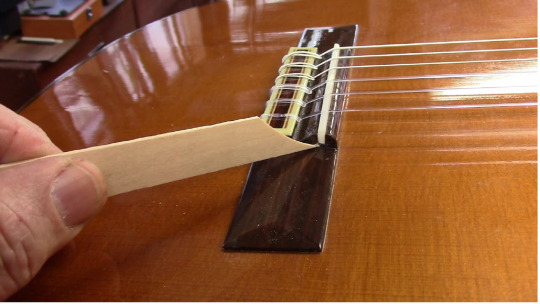
If you are like me and like to play all over the fretboard on your acoustic, you want it to sound great. A frequently overlooked fact is that guitar saddles have a larger influence on the ‘playability’ and ‘tone’ than you think!
Types of Guitar Bridge Saddles you can get:
If you’ve decided on your new guitar bridge but are confused with what type to go with, here’s our picks:
Nickel Plated Brass
Aged Nickel Plated Brass
Natural Brass
Aged Natural Brass
Titanium
Notched Vs. Unnotched Guitar Bridge Saddles
Most guitar bridges come pre-installed with notched saddles. This allows easy installation of your new bridge and starting to play it right away. It will be perfectly functional for your normal strings and if you ever wish to widen these, you might want the wound strings to sit deeper in the saddle.
This will make the wound strings fit perfectly without widening it much. In case you use a heavy gauge of string, you might go for it.
While the Unnotched saddles have a completely flat top. Before installation, you might need it to be noted for this configuration gives you the freedom to get a notch as per your requirement. Make sure to use specialised gauged files made precisely for this function. With the saddle notch deepening, you might want to take the help of a professional at this point.
Necessary Upgrades For Your Guitar Saddle
Most guitar players upgrade from nickel-plated brass to natural brass. It’s simply because brass provides a vintage look and feel. No audible tonal difference is there between these two options.
Further, you can add new one of important guitar parts titanium saddles to your Faber bridge saddles as they promise a brighter and tighter tone. Titanium saddles are the perfect upgrade if you feel your guitar is a little too dark sounding and you want to enhance the top-end response.
Read More: Learn to Select Best Guitar Bridge Saddles
1 note
·
View note
Text
How To Promote Your Music: A Beginners Guide

In the 1990s, the computer industry was hit by three major bombs. The first was the browser, which served as our portal to the internet. Then came the technologies for transmitting video and audio via this new channel, such as compressed video and audio. Then, in 1999, the music “sharing” website Napster was founded. From that point forward, the computer served as a single platform for recording, distributing, and consuming music.
Things were only beginning at the time. MySpace debuted in 2003, and within months, millions of users and hundreds of musicians and bands were discovering each other in ways never previously imaginable. As a result of these changes, a whole new music ecology has emerged. In the end, digital sales topped physical sales. Radio has been neglected by podcasts, streaming, and YouTube. Every laptop became a potential recording desk as studios shrank. Video links and digital profiles replaced the artist’s 810 advertising glossies.
What exactly is promotion?
Because self-promotion takes time and pushes many of us out of our comfort zones, You’ll be doing a lot of this work yourself if you don’t already have a publicist, management team, or major label contract.
Your marketing should aim to do one of three things: increase your visibility, establish your credibility as an artist, and provide you with income, whether it’s a brilliant YouTube video or an event poster on an old-school kiosk. Trust me, going live with your guitar on Instagram and playing a melodious old song with a perfect ambience behind you can trigger better than any other music promotion service.
Cover songs
It’s difficult to cover a song by an artist you adore. You’re almost certainly a fan of the original artist and want to give their song justice. We’ve all seen X-Factor, American Idol, and YouTube renditions that turn a legendary pop song into a dumpster fire, and no one wants to be the one to blame! However, if you do it well, you’ll undoubtedly gain new fans among those who share your feelings about the song.
You can choose any day of the week when you will be live on any social media platform and interact with your followers. You can play a melodious cover song on-demand, or you can share any tips for those who are learning guitar, or share a few “FYI” about guitars, guitar parts or bridges, or a story that would be engaging.
Read more – A Beginners Guide To Promote Music
0 notes
Text
Setting The Intonation On A Faber Bridge

When an instrument is properly intonated, all the open strings and every note on the fretboard sound at their correct pitches. If your guitar still sounds noticeably out of tune even after you’ve tuned the open strings, the intonation is off that is, the instrument is out of tune with itself. This effect is often slight rather than dramatic, but even slight intonation imbalances are noticeable enough to be annoying and demand adjustment.
After you’re done choosing your new Faber bridge for your guitar, you need to get started with the intonation. Faber guitar bridges being fully intonatable, the ABHR, ABRN, ABRM and Tone-Lock™ bridges intonation work almost similarly.
Step By Step Guide To Proper Intonation Of Your Faber Bridge
First, try to restring your guitar with the string gauge of your need.
Set up the guitar as per the pitch and adjust if required every time after changing the tuning or string gauge. After the tuning, stretch the guitar strings so that they hold the tune correctly.
To check the intonation, utilizing your electronic tuner, think about the pitch of the open string against the twelfth fret and the twelfth fret consonant on your Low E string. In the event that the pitch of the twelfth fret is sharply contrasted with the open string, you should add some length to the string. This is accomplished by releasing the seat change screw to move the seat further away from the nut. Because of the expansion in tension at the rear of the extension, the pitch of your strings will go sharp. Retune and check the sound once more.
In case the 12th fret is flat compared to the open string, move the saddle towards the nut and tighten the saddle adjustment screw at the bridge saddle. Slowly move the saddle towards the nut and once again the string pitch gets flat. Retune once after.
Note: When the guitar bridges saddle adjustment screw gets to the end of its seat, never force it to turn more than it freely does, which can lead to breaking the screw and damaging the saddle.
In case you have a normal Wraparound bridge, it’s not possible to set the intonation string by string basis. What you can do is, set the intonation across the overall bridge.
Faber does offer the Tone-Bar™ Compensated Wraparound bridge and the TPWC compensated “Lightning Bolt” style bridge making online guitar parts that you can replace on your own.
Read More: Setting the Intonation on a guitar bridge
0 notes
Text
Marketing For Independent Musicians

Become a Musician Who Isn’t Just a Musician
Getting your work out there doesn’t always mean you have to stay in that box. Becoming more than a musician is a challenge you might take on to broaden your horizons and make your talent known around the world.
The internet’s power is vast, and reaching out to your audience as a brand ambassador, influencer, or content provider may be extremely beneficial to your music.
There are numerous ways to build popularity, and once you have your audience’s attention, you can emphasize your song. This method is used by a lot of musicians, and it just goes to show that being more than a musician is a talent you can showcase to your listeners.
Playlists and Music Blogs are good places to start
If you’re advertising an album, having your music out there ahead of time will help you gain traction and reach as many people as possible. Pitching your music to the press as part of your music marketing strategy can help you gain exposure.
Any mention of your music in the media can help with your marketing efforts, as it can increase the number of people who listen to your music and improve the SEO of your band’s website.
Create an electronic press kit that reflects your objective, whether you’re hoping to acquire a spot for a premiere or release a single. Then, using a spreadsheet, find music blogs and Spotify playlists that are a good fit for you, and send an email with a link to your EPK to those who are a good fit.
Invest in a public relations/radio advertising
Consider employing a radio tracker or publicist to assist you in getting your music heard if you have a music marketing budget to invest in. The amount of money you’ll spend will be determined by the size and scope of the campaign you’re planning.
Remember that meaningful results may take thousands of dollars, and there’s no assurance that your song will be reviewed or picked up by radio stations – so budget carefully.
If you can’t afford a radio campaign, you can spend some extra time and effort contacting stations to have your music played on the air. You can also go for music promotion services with a DIY approach.
Read More: Marketing for Independent Musicians
0 notes
Text
Don't Buy Fake Spotify Streams - Here's Why!

Looping Scams
You might want to think twice if you’ve ever been tempted to leave your tunes looping overnight—or if you’ve ever asked your fans to do so.
This type of behaviour will be detected by Spotify and other streaming platforms, and it will not pay off.
You could be kicked off the platform and blacklisted for good.
Allow people to listen to your music in a natural way, and the streaming platforms will take notice.
Scams with playlists
While playlisting is a great way to reach new audiences and have your music heard, you should never pay money to be included in one.
Don’t waste your time or money on anyone who offers you the potential to increase your streams in exchange for a payment that grants you access to specific playlists.
Streaming sites are constantly on the lookout for these types of playlists, and you risk being detected and having your online reputation harmed.
So, Should You Purchase Spotify Plays?
On the internet, you may find many kinds of Music Promotion Services, but what truly important is the objective behind what you’re going to pay for. If you want to be sure that your organic development is genuine, you may (and should) pay for it. While it may take longer to build over the campaign, you will be gathering genuine friends and listeners who will most likely continue to support you.
I’ve always been a fan of DIY and practical promoting tactics, which means taking the time to create actual fans and loyal listeners before occasionally using Spotify playlist promotion service in a highly targeted way that is oriented towards a specific demographic, area, and conclusion. The figures won’t matter as much in the long run. The true audience is the one who recalls the music they actually enjoy; these are the folks who keep up with what you’re doing and come to your gigs to support you.
Read More: Don’t buy fake Spotify Streams
0 notes
Text
20 Effective Ways to Protect Your Guitar
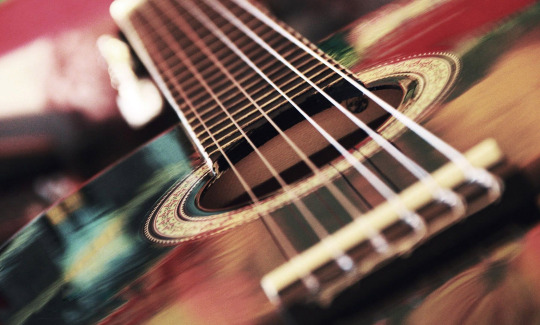
As an entertainment insurance brokerage with a specialty in creating custom insurance packages for musicians, we have seen enough music gear-related insurance claims to be able to speak with some authority on what musicians can do to protect their gear. As it’s one of the most popular instruments, let’s focus on the guitar in this article:
Protecting your Guitar | GUITAR MAINTENANCE
Where to keep your guitar? Store your guitar in a room closer to the center of the building rather than near an outside wall. This helps maintain a constant temperature.
Store the guitar in its case, standing up or on edge – never lying down – to prevent it from being stepped on. Also, loosen its strings one or two half-steps while the guitar is in storage.
Store vibrato-equipped guitars with arms detached.
Get a gig bag with some good padding and put your guitar in it whenever transporting it. Carrying the bag in your hand is OK, but it’s even safer to strap it to your back while walking with your guitar.
If you’re touring, always use a high-quality carrying case such as a hard-bodied, foam-lined, locking Pelican case that protects against impact & moisture.
Consider getting a guitar wall hangar to hang your guitar(s) on. When you hang the guitar on a wall hanger, little-to-no pressure is exerted on the neck of the guitar in a direction that could potentially distort, bend or warp it. This is a much better storage option than leaning the guitar against a wall, which could bend the neck.
Put a digital hygrometer in your guitar case to ensure humidity levels are under control. The ideal humidity range for an acoustic guitar is 45-55%, but 40-60% is generally considered acceptable. A good guitar humidifier will automate the humidity control process to stay within this range, making it easy to maintain proper humidification for your guitar while in its case. A well-reviewed one is the Oasis Guitar Humidifier.
Sometime you need to repair your guitar to maintain. Get the online guitar parts for quick repairing.
Read more – Guitar Maintenance Tips
0 notes
Text
CHOOSING THE BEST STRINGS FOR YOUR ELECTRIC GUITAR
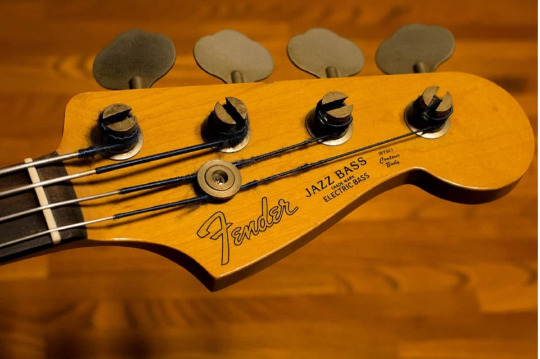
Electric guitar strings one of the important guitar parts play a significant role in the sound and playability of your instrument. The quality of the material, string gauge and brand are issues to consider and can often make your choice in finding the best strings a difficult one, especially when you’re faced find yourself having to choose from our assortment which has more than 700 different options!
String gauge
The first step towards finding your match is determining your preference in string size. The heavier the gauge, the thicker the strings meaning they’re stronger, stiffer and tense. While producing more resonance, heavy gauge strings require more pressure on the frets and strength in your fingers to apply said pressure.
Lighter gauge strings are generally recommended for beginner guitarists who still have sensitive fingers. They are also popular among shredders for fast solos and to facilitate the techniques of the left hand.
Heavier gauge strings are recommended for blues-rock guitarists, jazz guitarists and for slide and powerful rhythms.
Read More: Best Strings for Electric Guitar
0 notes